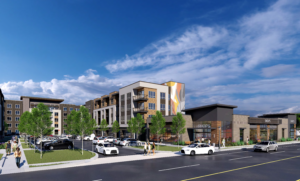
There is a greater demand for live-work-play communities in places like Arvada. These mixed-use developments combine residential, commercial, and cultural spaces into one location.
Most of us think of mixed-use developments as buildings with shops and cafes on the ground floor and apartments up top. This type of mixed-use development, commercial on the first floor and housing above, is what’s known as vertical mixed-used development. It works in downtown and transit-centric spaces but isn’t always a perfect fit for suburban cities like Arvada.
Vertical development isn’t the only game in town, though. Say hello to horizontal mixed-use development, which is like a puzzle where each piece is a different building with a dedicated use bringing something new and unique to the community. Residential and commercial spaces aren’t in the same buildings, but are within walking distance of each other on the same parcel of land.
Many of AURA’s developments utilize the horizontal mixed-use approach including the Caroline at Ralston and Ralston Commons developments along Ralston Road.
Horizontal and vertical mixed-use development have a common goal: mix things up and make spaces exciting! They’re like matchmakers, bringing different uses together in one spot.
There are many reasons residents seek mixed-use developments including environmental, lifestyle, and social motivations.
Mixed-use developments are designed to be walkable and bikeable. Residents live within walking distance of where they work or shop. Studies have shown that intelligent urban planning and mixed-use developments can foster sustainability and contribute to a greener future.
Residents living in closer proximity to restaurants and shops also have a built-in encouragement to get to know each other and build new relationships. The shared spaces of mixed-use developments have been shown to help alleviate loneliness. And the blended spaces of mixed-use developments have been shown to attract residents from all backgrounds creating a remarkable mosaic of our community.
But mixed-use development isn’t the silver bullet to urban problems. If not planned carefully, mixed-use spaces can fail to attract residents and may be rejected by the community. We have built our mixed-use spaces along corridors that are already in high demand including Wadsworth and Ralston to help the projects succeed.
But don’t worry – these developments won’t cause new traffic jams. A Traffic Impact Analysis by Kimley Horn estimated that replacing the abandoned Kmart with a comparable business would have created 5,070 daily trips to the area. The Caroline mixed-use project is projected to create only 2,072 daily trips.
It is easy to see why more and more people are looking for mixed-use developments to live, work, and play. They check many boxes for creating a balanced life and a healthy city.